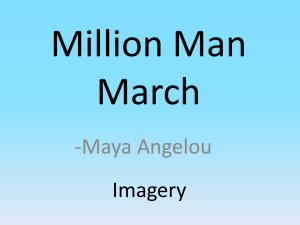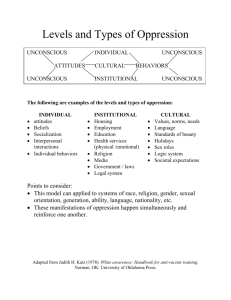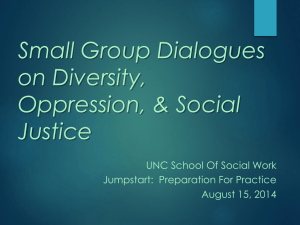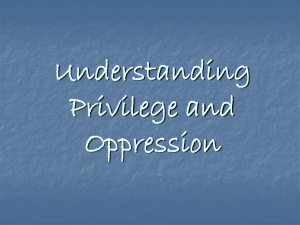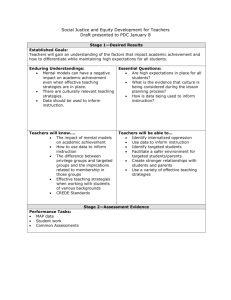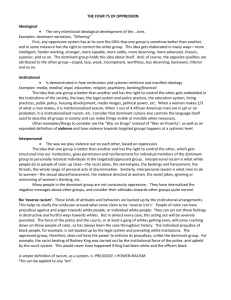Five Faces of Oppression
advertisement
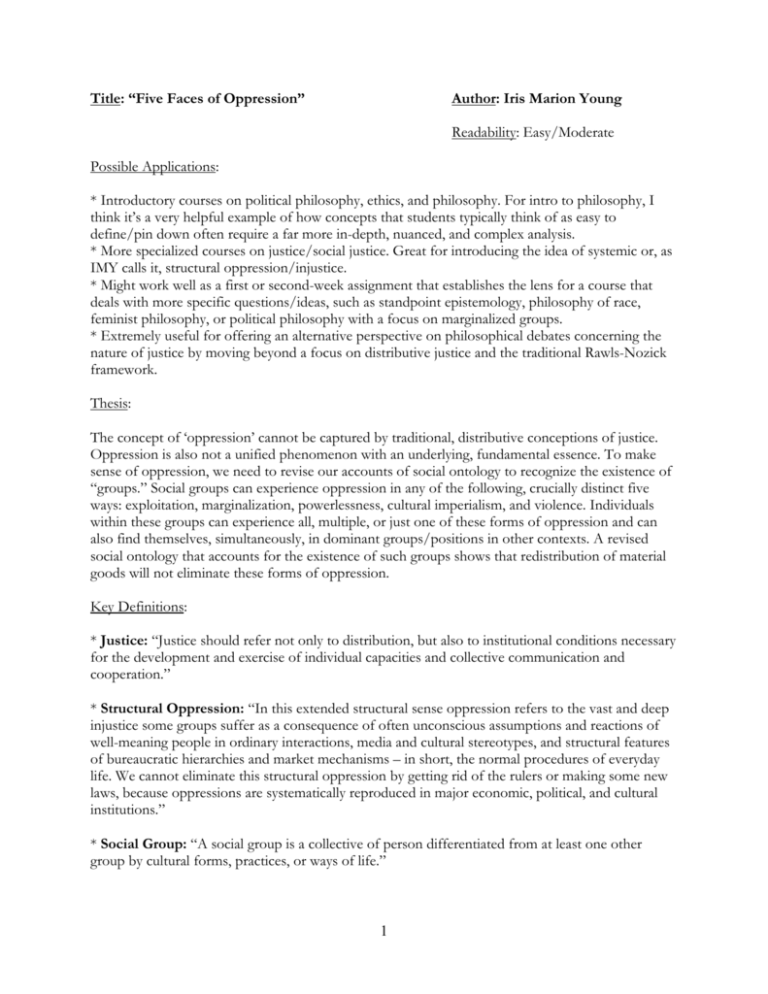
Title: “Five Faces of Oppression” Author: Iris Marion Young Readability: Easy/Moderate Possible Applications: * Introductory courses on political philosophy, ethics, and philosophy. For intro to philosophy, I think it’s a very helpful example of how concepts that students typically think of as easy to define/pin down often require a far more in-depth, nuanced, and complex analysis. * More specialized courses on justice/social justice. Great for introducing the idea of systemic or, as IMY calls it, structural oppression/injustice. * Might work well as a first or second-week assignment that establishes the lens for a course that deals with more specific questions/ideas, such as standpoint epistemology, philosophy of race, feminist philosophy, or political philosophy with a focus on marginalized groups. * Extremely useful for offering an alternative perspective on philosophical debates concerning the nature of justice by moving beyond a focus on distributive justice and the traditional Rawls-Nozick framework. Thesis: The concept of ‘oppression’ cannot be captured by traditional, distributive conceptions of justice. Oppression is also not a unified phenomenon with an underlying, fundamental essence. To make sense of oppression, we need to revise our accounts of social ontology to recognize the existence of “groups.” Social groups can experience oppression in any of the following, crucially distinct five ways: exploitation, marginalization, powerlessness, cultural imperialism, and violence. Individuals within these groups can experience all, multiple, or just one of these forms of oppression and can also find themselves, simultaneously, in dominant groups/positions in other contexts. A revised social ontology that accounts for the existence of such groups shows that redistribution of material goods will not eliminate these forms of oppression. Key Definitions: * Justice: “Justice should refer not only to distribution, but also to institutional conditions necessary for the development and exercise of individual capacities and collective communication and cooperation.” * Structural Oppression: “In this extended structural sense oppression refers to the vast and deep injustice some groups suffer as a consequence of often unconscious assumptions and reactions of well-meaning people in ordinary interactions, media and cultural stereotypes, and structural features of bureaucratic hierarchies and market mechanisms – in short, the normal procedures of everyday life. We cannot eliminate this structural oppression by getting rid of the rulers or making some new laws, because oppressions are systematically reproduced in major economic, political, and cultural institutions.” * Social Group: “A social group is a collective of person differentiated from at least one other group by cultural forms, practices, or ways of life.” 1 * Exploitation: “The central insight expressed in the concept of exploitation…is that this oppression occurs through a steady process of the transfer of the results of the labor of one social group to benefit another.” * Marginalization: “Marginals are people the system cannot or will not use”; “A whole category of people is expelled from useful participation in social life.” * Powerlessness: “The powerless are those who lack authority or power even in this mediated sense, those over whom power is exercised without their exercising it; the powerless are situated so that they must take orders and rarely have the right to give them.” * Cultural Imperialism: “[T]o experience how the dominant meanings of a society render the particular perspective of one’s own group invisible at the same time as they stereotype one’s group and mark it as the Other.” * Violence: “Violence is systemic because it is directed at members of a group simply because they are members of that group.” Summary: Intro: It wouldn’t occur to many of us to use the term “oppression” to refer to the injustice found in contemporary U.S. society. But this is the case for current (i.e., movements spawned in the 1960s) emancipatory social movements, and IMY wants to persuade the reader that this is the right designation. IMY’s starting point is reflection on the conditions of the wide variety of groups said to be oppressed by these movements. (She has a helpful list of the groups she has in mind.) Wants to “systematize” the meaning of oppression. -But it’s not possible to define a single set of criteria to describe the oppression of these groups (beyond a very vague account). Rather than a unified, monolithic phenomenon (disputes about which lead to misguided debates over whose oppression is more fundamental/grave), oppression in fact represents a “family of concepts and conditions, which I divide into five categories: exploitation, marginalization, powerlessness, cultural imperialism and violence.” All may involve injustices of distribution, but also extend beyond such injustices. Oppression as a Structural Concept: Traditional notion of oppression is “the exercise of tyranny by a ruling group,” along with, e.g., colonial domination. Communist societies taken to be paradigmatic. Oppression is therefore an evil perpetrated by Others, not our society. - According to the new left social movements, however, oppression can be carried out not just by a tyrannical ruler, but through the “everyday practices of a well-intentioned liberal society.” Oppression here is structural, which means it is not caused by specific policies or individuals, but has its causes in “unquestioned norms, habits, and symbols, in the assumptions underlying institutional rules and the collective consequences of following those rules.” [See above for IMY’s specific definition of structural oppression.] With systemic/structural oppression, there isn’t necessarily a transparent, correlate, conscious/intentional oppressing group. This oppression is embedded in everyday life. Of course this doesn’t mean people aren’t intentionally harmed within a system of oppression. 2 - Recognizing the complexity of how this oppression works also allows us to see how the same person can be both privileged and oppressed, depending on which aspects of their lives we’re looking at. Before giving an account of oppression of groups (which IMY thinks cannot be given an “essential definition”), we need to know what a “group” is. The Concept of a Social Group: [See above for IMY’s definition of social groups.] Traditional political phil often has no place for the concept of the social group, treating it either on the model of aggregates or associations. - Aggregate View: This model sees the basis for the grouping of individuals as a particular attribute. Groupings based on skin color, genitals, and age are such arbitrary classifications on this view. Since these groupings are arbitrary (and hence unjust according to this model), this view takes it to be a mistake to identify individuals based on them. But IMY argues that what defines a social group is not a particular attribute, but a shared sense of identity. - Association View: This model treats groups as a kind of formally organized institution, like a club, corporation, or political party. - For IMY, neither of these models is appropriate in the case of social groups because, on her view, groups constitute individuals, whereas these models treat the individual as already constituted prior to their participation in a group. Most conventional social ontology is atomistic/individualistic, assuming the individual is ontologically prior to the social (thereby treating the individual, normatively, as self-sufficient/independent/autonomous). But one finds oneself a member of (is “thrown” into) a group. This doesn’t mean one can’t leave one’s group and enter new ones, nor does this mean one can’t define the meaning of group identity for oneself. - The individualist model of social ontology also tends to assume that group identification = oppression. IMY wants to reject this claim: differentiation not in and of itself oppressive. - For IMY, groups only exist in relation to other groups. Groups can come to exist only because an outsider labels them as such. Individualist model does, though, have an important anti-essentialist strain. We need a new account of groups here. Group members do not have a common “nature” and groups themselves fade away and come into being. Group differences also cut across one another (i.e., one can be a member of multiple groups simultaneously). Group differentiation, on IMY’s view, is “multiple, cross-cutting, fluid, and shifting.” The Faces of Oppression - Exploitation: Fantastic summary at the beginning here of Marx’s theory of exploitation. [See above for IMY’s definition of exploitation.] The problem here isn’t just about inequality in distribution. There are structural relations that create a system where the energies and activity of the underclass is used to augment the power and 3 wealth of the elite. Need to revise the Marxist conception somewhat to make room for how the notion of exploitation applies to sexual and racial oppression. - Gender exploitation: the systematic and unreciprocated transfer of powers from women to men (e.g., material, emotional, sexual energies transferred to men). - Racial exploitation: clearly racialized groups are oppressed through capitalist superexploitation, but the question is whether there is a form of exploitation that is racially specific. IMY proposes the category of menial labor. This corresponds to the assumption that members of oppressed racial groups ought to serve those in the privileged group. Menial labor refers not just to service, but to servile, unskilled, low-paying work lacking in autonomy. (IMY takes menial labor to be a provisional category in need of further exploration.) Injustices of exploitation cannot be solved by redistribution of wealth because institutionalized practices/relation will simply reproduce inequality. - Marginalization: “Marginals are people the system cannot or will not use.” Most of these individuals are racially marked. (IMY has a list of groups she has in mind at the beginning of this section.) But also the elderly, the mentally and physically disabled, the unemployed, among many others. IMY sees marginalization as maybe the most dangerous form of oppression: “A whole category of people is expelled from useful participation in social life and thus potentially subjected to severe material deprivation and even extermination.” But the issue here isn’t just material: - First, the subjection to demeaning, patronizing, punitive, and arbitrary treatment by those in bureaucratic positions of authority. Rights to privacy, individual choice, and respect are suspended. Although dependency produces injustice in our society, there need not be anything unjust about dependency. Feminist moral theory has helped to problematize the assumption that citizenship requires independence/autonomy. - Second, marginalization, even when materially mitigated, results in feelings of uselessness, boredom, lack of self-respect, precluding the exercises of crucial faculties. - Powerlessness: Professional vs. nonprofessional forms of labor. Nonprofessionals suffer a form of oppression, in addition to exploitation, IMY calls powerlessness. Nonprofessionals do not participate in making decisions that profoundly affect their lives and actions and therefore lack power. “The powerless are those who lack authority or power even in this mediated sense, those over whom power is exercised without their exercising it; the powerless are situated so that they must take orders and rarely have the right to give them.” The powerless also have little work autonomy, creativity or judgment in their work, have little if any technical expertise or authority, and do not command respect. “This powerless status is perhaps best described negatively: the powerless lack the authority, status, and sense of self that professionals tend to have.” The privilege of professionals has three aspects (the lack 4 of which generates the oppression of nonprofessionals): first, being a professional allows for the progressive development of capacities and status; second, professionals have at least a certain degree of work autonomy; third, professionals and nonprofessionals occupy entirely different cultures, where the former are treated with a crucial sense of respectability denied to the latter. These differing cultural norms become especially apparent in the dynamics of racism and sexism. - Cultural Imperialism: Exploitation, marginalization, and powerlessness all refer to relations of oppression that occur by virtue of the social division of labor; they’re a matter of concrete power in relation to others: who works for whom and who is dispensable. But “cultural imperialism means to experience how the dominant meanings of a society render the particular perspective of one’s own group invisible at the same time as they stereotype one’s group and mark it as the Other.” Cultural imperialism establishes the dominant group’s experience and culture as the norm, defining other groups as deviant and/or inferior. Helpful discussion of DuBois’s “double consciousness.” Because members of culturally dominated groups can recognize and affirm their shared sense of experience/perspective, they can often maintain a sense of positive subjectivity. Cultural imperialism involves a paradoxical form of oppression: one experiences oneself as marked out as different and as invisible. “This, then, is the injustice of cultural imperialism: that the oppressed group’s own experience and interpretation of social life finds little expression that touches the dominant culture, while that same culture imposes on the oppressed group its experience and interpretation of social life.” - Violence: The oppression of systematic violence, where an individual is subjected to random, unprovoked attacks on their property or person where the only motive is to damage, humiliate, or destroy the person for being part of an oppressed group. Beyond physical attacks, IMY takes this violence to refer to the intimidation, harassment, and ridicule individuals also face. Traditional theorists of justice tend to assume that acts of violence are committed by extremists. What makes violence a form of oppression, though, is not just the physical acts themselves, but the social context surrounding them/their existence as a social practice. “Violence is systemic because it is directed at members of a group simply because they are members of that group.” The oppression isn’t so much about direct victimization, but the daily knowledge that members of these groups are liable to violation solely because of their group identity. Systemic violence is irrational for IMY in the sense that it is motivated by fear/hatred, rather than, say, repressive violence that is used as a political, coercive tool. Class Activities: * I think this would be a very good paper to have students practice outlining. * A Q & A worksheet might also work well, where you could have students track IMY’s arguments. (Examples: Why does IMY think the concept of oppression is not fully captured by distributive theories of justice? Give specific examples. What is IMY’s criticism(s) of the “individualist” model of social ontology?) 5 * It might be helpful to juxtapose the article with other, more specific pieces that deal with the issues in one of IMY’s categories and see how her analysis applies/works in connection with it. * You could ask students to find their own real-world examples of IMY’s categories, or provide your own, and have them discuss whether they feel IMY’s analysis is successful. 6
